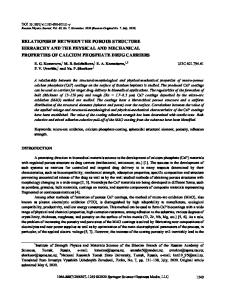The Random Porous Structure and Mechanical Response of Lightweight Aluminum Foams
- PDF / 3,079,868 Bytes
- 9 Pages / 612 x 792 pts (letter) Page_size
- 58 Downloads / 297 Views
THE RANDOM POROUS STRUCTURE AND MECHANICAL RESPONSE OF LIGHTWEIGHT ALUMINUM FOAMS Max Larner1, John Acker2 and Lilian P. Dávila1,* 1 Materials Science and Engineering 2 Computer Science and Engineering School of Engineering University of California Merced, 5200 N. Lake Road, Merced, CA 95343, U.S.A ABSTRACT Lightweight porous foams have been of particular interest in recent years, since they have a very unique set of properties which can be significantly different from their solid parent materials. These properties arise from their random porous structure which is generated through specialized processing techniques. Their unique structure gives these materials interesting properties which allow them to be used in diverse applications. In particular, highly porous Al foams have been used in aircraft components and sound insulation; however due to the difficulty in processing and the random nature of the foams, they are not well understood and thus have not yet been utilized to their full potential. The objective of this study was to integrate experiments and simulations to determine whether a relationship exists between the relative density (porous density/bulk density) and the mechanical properties of open-cell Al foams. Compression experiments were performed using an Instron Universal Testing Machine (IUTM) on ERG Duocel open-cell Al foams with 5.8% relative density, with compressive loads ranging from 0-6 MPa. Foam models were generated using a combination of an open source code, Voro++, and MATLAB. A Finite Element Method (FEM)-based software, COMSOL Multiphysics 4.3, was used to simulate the mechanical behavior of Al foam structures under compressive loads ranging from 0-2 MPa. From these simulated structures, the maximum von Mises stress, volumetric strain, and other properties were calculated. These simulation results were compared against data from compression experiments. CES EduPack software, a materials design program, was also used to estimate the mechanical properties of open-cell foams for values not available experimentally, and for comparison purposes. This program allowed for accurate prediction of the mechanical properties for a given percent density foam, and also provided a baseline for the Al foam samples tested via the IUTM method. Predicted results from CES EduPack indicate that a 5.8% relative density foam will have a Young’s Modulus of 0.02-0.92 GPa while its compressive strength will be 0.34-3.37 MPa. Overall results revealed a relationship between pores per inch and selected mechanical properties of Al foams. The methods developed in this study can be used to efficiently generate open-cell foam models, and to combine experiments and simulations to calculate structure-property relationships and predict yielding and failure, which may help in the pursuit of simulation-based design of metallic foams. This study can help to improve the current methods of characterizing foams and porous materials, and enhance knowledge about their properties for novel applications. * Corresponding Author: ldavil
Data Loading...











